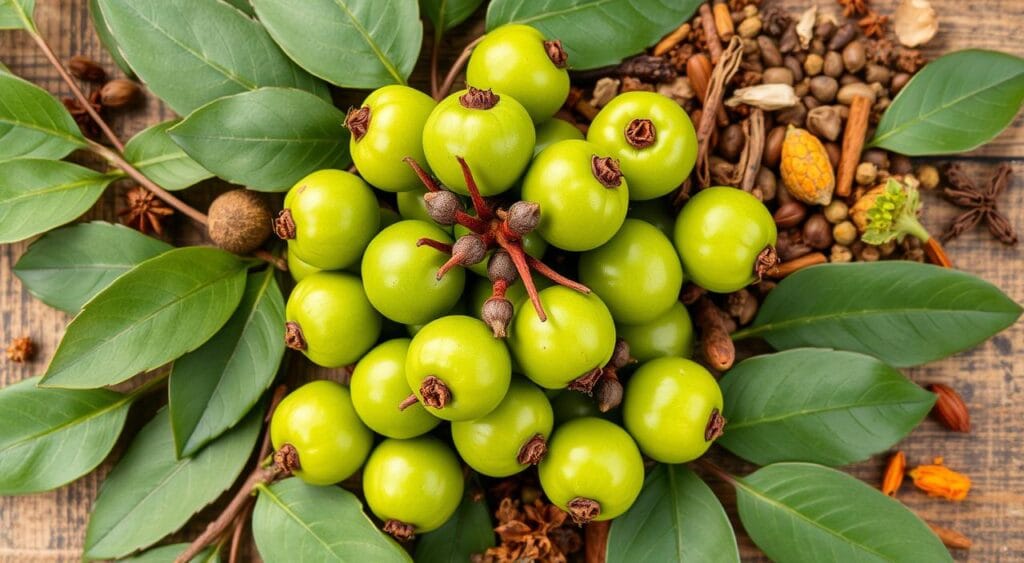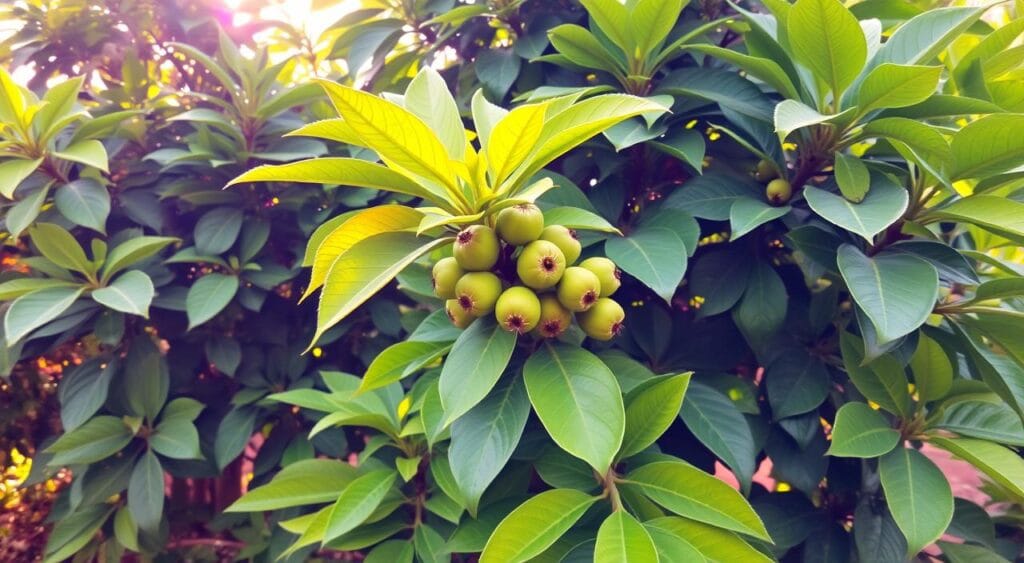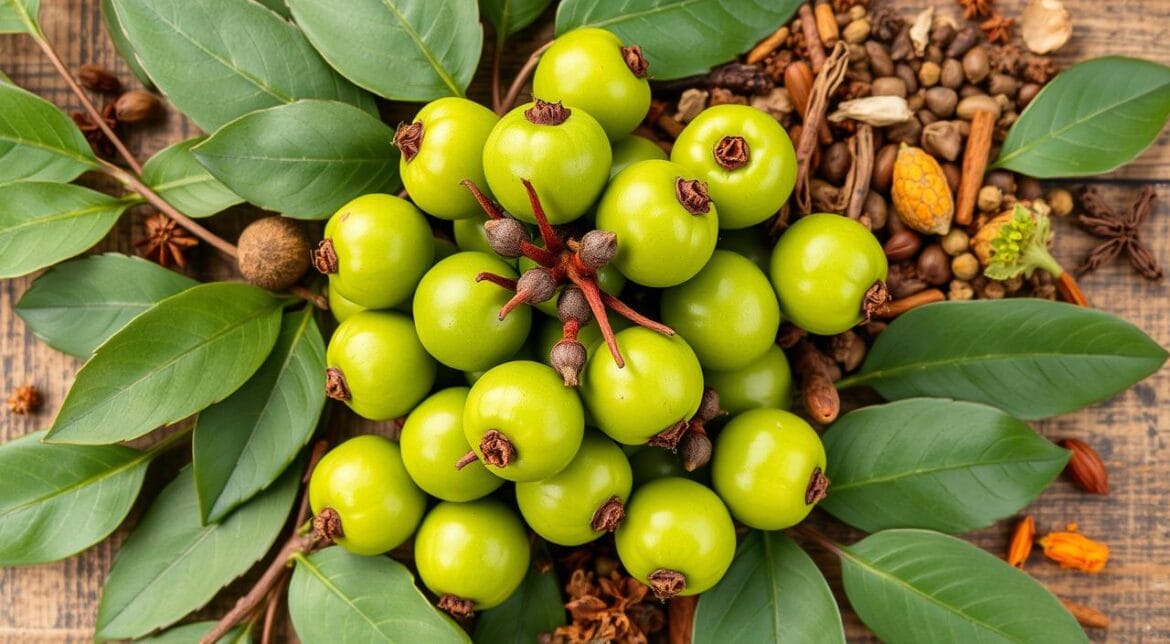Table of Contents
Sundakkai Benefits: Health Benefits of This Versatile Ingredient
Sundakkai, also known as turkey berry or pea eggplant, is becoming more popular in health-focused diets worldwide. This ingredient, known scientifically as Solanum torvum, is packed with nutrients and health benefits. It has been a staple in South Asian cooking and healing for centuries.
Sundakkai is not just good for cooking; it’s also great for your health. It helps with digestion and boosts your immune system. This guide will show you how sundakkai can be a key part of a healthy diet.

Key Takeaways
- Sundakkai, also known as turkey berry or pea eggplant, is a highly nutritious and versatile ingredient with a rich history in traditional South Asian cuisine and medicine.
- This ingredient, scientifically named Solanum torvum, offers a wide range of health benefits, including supporting digestive health, reducing inflammation, and boosting the immune system.
- Sundakkai is a valuable addition to a well-balanced, health-conscious diet, offering a unique flavor profile and a wealth of essential vitamins, minerals, and antioxidants.
- Incorporating sundakkai into your meals can provide numerous benefits for overall well-being, making it a must-try ingredient for those seeking to optimize their health and wellness.
- Explore the diverse culinary and medicinal applications of sundakkai to unlock its full potential and discover new ways to enhance your diet and lifestyle.
What is Sundakkai: Understanding This Traditional Ingredient
Sundakkai, also known as turkey berry or garden egg, is a versatile ingredient. It comes from the Solanaceae family. This small, round fruit has a unique flavor and many sundakkai uses and sundakkai medicinal properties.
Origins and Cultural Significance
Sundakkai has been a key part of traditional cuisines and healing in India, Sri Lanka, and other South Asian regions for centuries. It was first cultivated in these areas. It’s valued for its sundakkai medicinal properties and for enhancing the flavors of fresh green sundakai sambar and other dishes.
Botanical Classification and Growth
Sundakkai is classified as Solanum torvum, belonging to the Solanaceae or nightshade family. It’s a hardy perennial shrub that can reach up to 6 feet in height. It has distinctive green leaves and small, round fruits that turn from green to deep purple or black.
Different Forms of Sundakkai
- Fresh sundakkai: The ripe, green or purple-black fruits are commonly used in various sundakkai uses in cooking, such as fresh green sundakai sambar.
- Dried sundakkai: The fruits can be dried and powdered, creating a versatile ingredient for adding to spice blends, curries, and other dishes.
- Sundakkai powder: The dried and ground sundakkai fruits are used in traditional medicine and as a seasoning in various South Asian cuisines.

“Sundakkai is a cherished ingredient in South Asian cuisine, celebrated for its rich history and diverse culinary and medicinal uses.”
Nutritional Profile of Sundakkai
Sundakkai, also known as turkey berry or scarlet eggplant, is a nutrient-dense vegetable. It has a remarkable nutritional profile. Its sundakkai nutrition and sundakkai nutritional value make it a valuable addition to a healthy diet. Let’s explore the key nutrients found in this versatile ingredient.
Sundakkai is low in calories yet packed with essential vitamins and minerals. It is an excellent source of vitamin C, providing nearly 30% of the recommended daily intake in a single serving. Additionally, it contains significant amounts of vitamin A, vitamin K, and folate. All of these play crucial roles in supporting overall health.
| Nutrient | Amount per 100g |
|---|---|
| Calories | 24 |
| Carbohydrates | 5g |
| Protein | 1g |
| Fat | 0.2g |
| Fiber | 3g |
| Vitamin C | 27mg |
| Vitamin A | 480IU |
| Vitamin K | 11.2μg |
| Folate | 16μg |
Sundakkai also contains a variety of antioxidants, including carotenoids and flavonoids. These contribute to its anti-inflammatory properties and support the immune system. Its high fiber content further promotes digestive health and regularity.
Compared to other commonly consumed vegetables, sundakkai stands out. It has exceptional nutrient density and a low-calorie profile. This makes it an excellent choice for a balanced and nutritious diet.
Essential Sundakkai Benefits for Overall Health
Sundakkai is a versatile ingredient with roots in traditional medicine. It offers many sundakkai advantages and sundakkai health benefits for your overall well-being. It helps with digestion, fights inflammation, and boosts your immune system. This makes it a powerful ally for your body.
Digestive Health Properties
Sundakkai is high in fiber, which is great for digestive health. The soluble fiber in it helps with bowel movements and a healthy gut. It also helps with constipation and bloating.
By feeding good gut bacteria, sundakkai improves nutrient absorption. This leads to better gut wellness.
Anti-inflammatory Effects
Sundakkai is known for its anti-inflammatory properties. It contains flavonoids and phenolic acids. These compounds reduce inflammation at the cellular level.
This can help with chronic conditions like arthritis and skin irritations. It may also help with some heart problems.
Immune System Support
The sundakkai therapeutic effects also support the immune system. It’s packed with vitamins and minerals like vitamin C. Vitamin C helps immune cells work better.
Antioxidants like carotenoids protect the body from damage. They strengthen the immune response.
Adding sundakkai to your diet can bring many health benefits. It helps with digestion, fights inflammation, and boosts your immune system. This makes it a superfood worth trying.
Therapeutic Applications in Traditional Medicine
Sundakkai, also known as turkey berry or wild eggplant, has a rich history in traditional medicine. It’s valued for its sundakkai medicinal properties and sundakkai therapeutic effects. This makes it a popular remedy for many health issues.
In Ayurvedic practices, sundakkai helps with digestive problems. It has anti-inflammatory and carminative properties. These help with bloating, constipation, and indigestion. Sundakkai also helps with respiratory issues like cough and bronchitis because of its expectorant qualities.
The Siddha tradition, an ancient Tamil system of medicine, also values sundakkai. It’s used to treat skin conditions like eczema and psoriasis. This is due to its antimicrobial and antioxidant effects. Some studies suggest it may also help with neurological disorders.
| Traditional Medical Use | Purported Sundakkai Therapeutic Effects |
|---|---|
| Digestive Disorders | Anti-inflammatory, Carminative |
| Respiratory Issues | Expectorant |
| Skin Conditions | Antimicrobial, Antioxidant |
| Neurological Disorders | Neuroprotective |
More research is needed to fully understand sundakkai’s medicinal properties. Yet, its traditional use in Ayurvedic and Siddha medicine shows its potential. It could be a valuable natural remedy for many health concerns.
How Sundakkai Supports Digestive Wellness
Sundakkai is more than just a tasty ingredient. It’s also great for your digestive health. This vegetable is a key player in keeping your gut healthy and easing digestive problems.
Gut Health Enhancement
Sundakkai is known for its good effects on the gut. It’s full of fiber, which helps keep the gut flora balanced. This balance is crucial for absorbing nutrients, improving digestion, and boosting the immune system.
Natural Digestive Aid Properties
Sundakkai is a natural aid for digestion. Its fiber helps keep bowel movements regular, preventing constipation. It also might boost digestive enzymes, helping your body digest food better.
Relief from Common Digestive Issues
Eating sundakkai can help with many digestive issues. Its anti-inflammatory properties can ease bloating, gas, and indigestion. Its fiber can also help with constipation and diarrhea, fixing the root causes of digestive problems.
Discover the amazing sundakkai benefits for your digestive health and overall well-being. Use this versatile ingredient to support a healthy gut and a balanced life.
Popular Sundakkai Recipes and Preparations
Sundakkai, also known as turkey berry or purple eggplant, is a versatile ingredient. It shines in many traditional South Indian dishes. From the vibrant fresh green sundakai sambar to the aromatic sundakkai paruppu usili, it adds a unique flavor to home-cooked meals.
The fresh green sundakai sambar is a beloved sundakkai recipe. It’s a comforting and nourishing lentil-based stew. The mix of sundakkai, aromatic spices, and tangy tamarind is both satisfying and healthy.
The sundakkai paruppu usili is great for those looking for a protein-rich dish. It combines sundakkai’s unique taste with lentils’ richness. This makes a delicious side dish that goes well with steamed rice or flatbread.
Sundakkai can also be used in modern, healthy recipes. Add diced sundakkai to vegetable stir-fries or roast it with olive oil and spices. This makes a nutritious and tasty side dish.
Whether you’re an experienced home cook or new to South Indian cuisine, sundakkai is full of possibilities. Embrace its versatility and explore the many ways to enhance your meals with its flavors and health benefits.
Best Ways to Include Sundakkai in Your Diet
Adding sundakkai to your daily meals can boost your health. You can use it fresh or dried. It brings a unique taste and lots of nutrients. Here are the best ways to enjoy sundakkai and get its health benefits.
Fresh vs. Dried Sundakkai Usage
Fresh sundakkai is vibrant and juicy, perfect for many dishes. Try it in curries, stir-fries, or salads. Dried sundakkai is packed with nutrients, great for powders and supplements. Both forms offer sundakkai uses and sundakkai dietary benefits for better health.
Storage and Preservation Tips
Keeping sundakkai fresh is key to enjoying its nutrients. Store fresh sundakkai in the fridge in a sealed bag. Dried sundakkai goes in an airtight container in a cool, dark spot. This keeps its antioxidants and flavor strong.
Recommended Daily Intake
The daily sundakkai intake varies based on your health goals. Eating a serving or two of sundakkai daily offers many sundakkai dietary benefits. Consult a doctor to determine the appropriate amount for you.
| Fresh Sundakkai | Dried Sundakkai |
|---|---|
| Ideal for curries, stir-fries, and salads | Excellent for powders, spice blends, and supplements |
| Store in the refrigerator in a sealed container | Store in an airtight container in a cool, dry place |
| Provides a vibrant purple hue and juicy texture | Concentrates nutritional properties |
Potential Side Effects and Precautions
Sundakkai is usually safe and healthy. However, it’s important to be aware of potential side effects and precautions. Everyone reacts differently, so start small and watch how your body does.
Some people might have allergic reactions to sundakkai, especially if they’re sensitive to nightshade veggies. This could cause skin issues, stomach problems, or breathing troubles. If you get any bad reactions, stop eating sundakkai and talk to a doctor.
Sundakkai might also affect certain medicines. This includes blood thinners, antidepressants, and diabetes meds. If you’re on any meds or have health issues, check with your doctor before eating sundakkai.
To avoid side effects, do the following:
- Start with small amounts and gradually increase your consumption to gauge your body’s tolerance.
- Consult a healthcare professional, especially if you have any underlying health conditions or are taking medications.
- Avoid consuming sundakkai in excess, as high doses may lead to digestive discomfort or other adverse effects.
By being careful and aware, you can enjoy sundakkai safely. It offers many sundakkai wellness advantages for your health.
Purchasing and Storage Guidelines
Adding sundakkai to your dishes is exciting. But, picking the right one and storing it right is crucial. Whether you want fresh, dried, or powdered sundakkai, knowing how to choose and store it is important.
Selection Tips
For fresh sundakkai, choose fruits that are firm and green. Steer clear of any that are wrinkled or have bruises. When buying dried or powdered sundakkai, check for freshness. Look for a tight seal and a nice smell.
Storage Methods
- Fresh sundakkai: Store in the fridge in a bag or container. This keeps it fresh for up to 5 days.
- Dried sundakkai: Store in an airtight container in a cool, dark spot. This keeps the flavor and nutrients for months.
- Sundakkai powder: Store in a sealed jar in a cool, dry place. This keeps it potent for up to 6 months.
Shelf Life Information
| Sundakkai Form | Shelf Life | Signs of Spoilage |
|---|---|---|
| Fresh | Up to 5 days when refrigerated | Wilting, discoloration, soft texture |
| Dried | 6-12 months when stored properly | Musty odor, clumping, mold growth |
| Powdered | Up to 6 months when stored properly | Faded color, off-putting smell, caking |
By following these tips, your sundakkai uses and fresh green sundakai sambar recipes will be the best. You’ll get the most flavor and nutrition from your sundakkai.
Conclusion
The sundakkai is a powerful ingredient with a long history in traditional medicine. It offers many health benefits, from aiding digestion to boosting the immune system. This makes it an excellent addition to your diet.
Adding sundakkai to your meals can greatly improve your health. You can enjoy it fresh, dried, or in your favorite dishes. It’s packed with sundakkai benefits and sundakkai wellness advantages to discover.
Make sundakkai a key part of your kitchen for better health. Its many benefits make it perfect for those looking to nourish their bodies. Start enjoying sundakkai and take a step towards a healthier, more vibrant life.
FAQ
What is sundakkai?
Sundakkai, also known as turkey berry or pea eggplant, is a versatile ingredient. It’s popular for its health benefits. It belongs to the Solanaceae family and is used in traditional medicine and cooking, especially in South Asia.
What are the nutritional benefits of sundakkai?
Sundakkai is packed with nutrients but low in calories. It’s rich in vitamins, minerals, fiber, and antioxidants. These compounds support health, including digestion, inflammation, and immunity.
How can sundakkai benefit my digestive health?
Sundakkai is great for your digestive health. Its fiber promotes gut health and regular bowel movements. It also helps with constipation, bloating, and indigestion.
What are some traditional medicinal uses of sundakkai?
Sundakkai is used in Ayurveda and Siddha medicine. It treats respiratory issues, skin problems, and digestive disorders. Ongoing research supports its traditional uses.
How can I incorporate sundakkai into my diet?
Enjoy sundakkai fresh, dried, or powdered. It’s a key ingredient in South Indian dishes like sundakai sambar and sundakkai paruppu usili. You can also add it to modern recipes for a health boost.
Are there any possible side effects or precautions I should consider?
Sundakkai is generally safe, but watch for allergies or sensitivities. Always check with a healthcare professional, especially if you have health issues or take medications.
How should I store and preserve sundakkai?
Store fresh sundakkai in the fridge. Keep dried or powdered forms in a cool, dry place. Proper storage keeps sundakkai’s nutritional value high. Always check for spoilage before eating.

